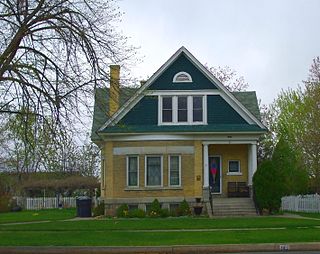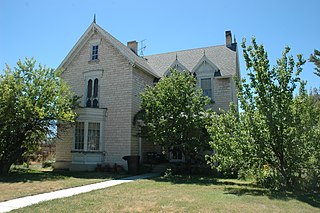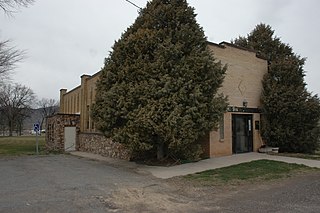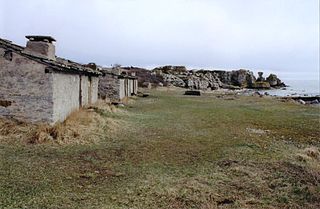
The John Adams Birthplace is a historic house at 133 Franklin Street in Quincy, Massachusetts. It is the saltbox home in which the second president of the United States, John Adams, was born in 1735. The house was designated a National Historic Landmark in 1960, and is listed on the National Register of Historic Places. It is now administered by the National Park Service as part of the Adams National Historical Park, and is open for guided tours.

Boxwood Hall State Historic Site, located at 1073 East Jersey street in Elizabeth, New Jersey, is a five bay middle-Georgian wooden structure with a tripartite Palladian window. In its original configuration ca. 1750 the house had two wings bringing the number of rooms to eighteen. The main block is a classic four over four center hall construction.

The Mordecai House, built in 1785, is a registered historical landmark and museum in Raleigh, North Carolina that is the centerpiece of Mordecai Historic Park, adjacent to the Historic Oakwood neighborhood. It is the oldest residence in Raleigh on its original foundation. In addition to the house, the Park includes the birthplace of President Andrew Johnson, the Ellen Mordecai Garden, the Badger-Iredell Law Office, Allen Kitchen and St. Mark's Chapel, a popular site for weddings. It is located in the Mordecai Place Historic District.

MacAlpine, Rebecca's Lot is a historic home located at Ellicott City, Howard County, Maryland, United States. It was built by wealthy Baltimore attorney, James Mackubin, for his second wife, Gabriella Peter, a great-great-granddaughter of Martha Washington. She grew up at nearby Linwood, the daughter of Maj. George Washington Parke Custis Peter, who was the second son of Martha Parke Custis Peter of Tudor Place, Georgetown. She attended the famed Patapsco Female Institute and was a leading society member in Maryland. She was a cousin of Robert E. Lee's wife and his children spent many summers here after his death. Gabriella was known to be gracious but demanding. She initially lived at nearby Grey Rock but refused to stay there long as her husband had shared that home with his first wife. Her daughters were unable to leave her side during her lifetime, especially after the accidental 1903 death of her youngest son, Parke Custis, rendering them middle-aged spinsters at the time of her death.

Peter Peterson Farmstead, also known as Emel Peterson Farmstead, near Waverly, Nebraska, United States, dates from 1893. It was listed on the National Register of Historic Places in 1980.

The Carl and Ulrika Dalander Cassel House is a historic residence located in Madrid, Iowa, United States. This Greek Revival structure is believed to be the oldest frame house in town. Built in 1862, it is associated with Swedish settlement in Iowa. Carl Cassel came with his father and the first group of immigrants to the Iowa Territory in 1845. They settled in a place they called New Sweden. Anna Dalander led another group of immigrants the following year and intended to settle in the same place, but they took the wrong river and ended up in Boone County. They named their settlement Swede Point, which was later renamed Madrid. Cassel married Dalander's daughter Ulrika in 1848. He and his brothers-in-law operated a grist mill. He also farmed and was involved in local politics. This house was located on the edge of his farm and the town. Cassel probably lived here until his death in 1902. The house was listed on the National Register of Historic Places in 1994.

The John Hultquist House is a historic building located in Swedesburg, Iowa, United States. Hultquist was a native of Småland in Sweden who immigrated to this country in 1880. After working for the Chicago, Burlington and Quincy Railroad he began farming and he was eventually able to buy 200 acres (81 ha) of land for his own farm north of town. In 1918 Hultquist employed C.K. Schantz to build this two story, frame, American Foursquare for he and his second wife Amanda after his retirement. It was fairly common for the early Swedish immigrants in Wayne Township to relocate to Swedesburg after they retired from farming so as to maintain their Swedish traditions. The house was listed on the National Register of Historic Places in 1999. The historic designation also includes a small barn to the east of the house. The front gable structure originally housed horses, a cow and chickens.

The Brown-Chenault House, also known as Campbell Farm, is a historic house in Castalian Springs, Tennessee, U.S..

The Daniel Pond Farmhouse, also known as Eggleston Farm, is a limestone-walled home built in Rutland, Wisconsin in the 1840s. In 1980 the house was listed on the National Register of Historic Places.

The Jacob and Cristina Thunborg House is a historic log cabin located at Chicken Point in Hayden Lake, Idaho. It was built in 1893-1902 by Jacob Thunborg and his wife Cristina, two Swedish immigrants who became homesteaders in Idaho. The Thunborgs lived here with their son, Frank, and their daughter, Lena. It was inherited by their daughter-in-law, Frances Thunborg, who lived here until 1960. The house has been listed on the National Register of Historic Places since September 12, 1985.

The Alma Compton House is a historic house in Brigham City, Utah. It was built in 1908 as a cottage for Alma Compton, an immigrant from England, and designed in the Victorian style. Compton, who became a professional photographer in Brigham City, lived here with his wife, née Jane E. Dalton, his son Matthew, and his two daughters. The Comptons were Mormons. The house has been listed on the National Register of Historic Places since April 7, 1988. The Compton Studio Photographs collection at Utah State University includes "over 100,000 original photographic negatives."

The Peter and Anna Christena Forsgren House is a historic house in Brigham City, Utah. It was built in 1857 for Peter A. Forsgren, an immigrant from Sweden who converted to The Church of Jesus Christ of Latter Day Saints at the age of 36, while he was living in Boston, Massachusetts. His brother, John E. Forsgren, who became the first Mormon missionary to preach in Sweden, played a leading role in his conversion. Forsgren became a weaver of cloth, blankets and carpets in Brigham City, and he designed a carpet for the Logan Utah Temple. This house was designed in the Gothic Revival architectural style. Even though Peter had two wives, his second wife is unlikely to have lived here with him. Forsgren therefore lived here with his first wife, also known as his sister wife, Anna Christena, and the house was deeded to their children, purchased by a daughter, sold out of the family in 1920. The new homeowner, Peter Nelson Pierce, was a trader between Native Americans and Mormon settlers who served as the local Mormon bishop and later became the police chief. The house has been listed on the National Register of Historic Places since January 23, 2003.

The Rider-Pugh House is a historic house in Kanab, Utah. It was built in 1892-1894 for John Rider, an immigrant from Ireland who converted to The Church of Jesus Christ of Latter-day Saints in 1855 and settled in Utah in 1886. Rider initially lived near Salt Lake City with his wife, née Mary McDonald, and their two children. He moved to a fort in Kanab in 1870, and he purchased the plot of land upon which this house was built in 1889. The house designed in the Late Victorian style. Underneath the foyer, there is a "polygamy pit". In 1895, the house was acquired by Edward Pugh, an immigrant from England who also converted to the LDS Church and arrived in the United States in 1844. Pugh had two wives, Mary Ann Rock Williams and Elizabeth Kelly, although his first wife lived in Salt Lake City. The house was deed to their daughter, Pearl Edna Pugh Brown, in 1914. It has been listed on the National Register of Historic Places since April 6, 2001.

The John Henry Shafer House is a historic house in Moab, Utah. It was built in 1884 for John Henry Shafer, a member of The Church of Jesus Christ of Latter-day Saints who moved to Moab from Salt Lake City with other Mormon settlers in 1878. Shafer married Mary Forbush in 1881, and they lived in this house, designed in the Victorian Eclectic style, until she died in 1889. He later married Sariah Eveline Johnson. Shafer was a Republican, and he served as the first member of the Utah House of Representatives from Grand County, Utah. The house was deeded to John Tangren, an immigrant from Sweden, in 1891; he lived here with his wife, Ester Alien, who was the president of the local Relief Society. It later purchased by two ranchers: Dale M. Parriot in 1912, and Richard L. Holyoak in 1941. The house has been listed on the National Register of Historic Places since May 2, 2001.

The Niels Ole Anderson House is a historic house in Ephraim, Utah. It was built in 1868 for Niels Ole Anderson, an immigrant from Sweden whose parents converted to The Church of Jesus Christ of Latter-day Saints and settled in Utah in 1854-1855, when Anderson was ten years old. He served in the Black Hawk War in 1865. Anderson lived in this house, designed in the Greek Revival and Federal styles, with his first wife, Josephine Overglade, and their nine children. He served as a missionary in his native Sweden from 1880 to 1882. After his wife died in 1884, he married Matilda Nielson in 1885, and they had a son, Niels Henry. The house was inherited by his ancestors. It has been listed on the National Register of Historic Places since October 5, 1978.

The Charles Crawforth Farmstead is a historic house on a farm in Spring City, Utah. It was built with limestone in 1884 by Charles Crawforth, an immigrant from England who converted to The Church of Jesus Christ of Latter-day Saints in 1854 and settled in Provo, Utah in 1855. Crawforth moved to Spring City in 1873 with his family, and he built this house, designed in the Greek Revival architectural style, in 1884. From his death in 1910 to 1918, it belonged to his son Charles L. Crawforth. It has been listed on the National Register of Historic Places since February 19, 1980.

The Greaves-Deakin House is a historic two-story house in Ephraim, Utah. It was built in 1875 by Peter Greaves, a native of Paterson, New Jersey who converted to The Church of Jesus Christ of Latter-day Saints with his family in the late 1840s and moved to Sanpete County in 1856. He became a landowner and the president of Andrews and Co., a shipping company based in Nephi, and he also served as a member of the Territorial Legislature from 1891 to 1896. The house was designed in the Greek Revival and Gothic Revival architectural styles. It was inherited by one of his daughters and son-in-law, William Price Deakin. It has been listed on the National Register of Historic Places since October 3, 1980.

The Robert Johnson House is a historic two-story house in Manti, Utah. It was built with limestone in 1860 for Robert Johnson, an immigrant from England who converted to The Church of Jesus Christ of Latter-day Saints and settled in Utah in 1853. He became a prosperous farmer in Manti. The house has been listed on the National Register of Historic Places since October 14, 1980.

The Niels P. Hjort House is a historic house in Fairview, Utah. It was built with limestone in 1878 by Niels P. Hjort, an immigrant from Norway who converted to The Church of Jesus Christ of Latter-day Saints and settled in Fairview in 1870. His house was designed in the Greek Revival style. It has been listed on the National Register of Historic Places since October 3, 1980.

The N. S. Nielson House is a historic house in Mount Pleasant, Utah. It was built in 1892 for N. S. Nielson, an immigrant from Sweden who converted to The Church of Jesus Christ of Latter-day Saints and settled in Utah in 1868. Nielson became a large sheep farmer. He was also president of the Mount Pleasant Commercial and Savings Bank, and the mayor of Mount Pleasant from 1896 to 1897. His house was designed in the Victorian Eclectic architectural style, with Second Empire, Queen Anne, and Beaux-Arts Classical features, and a "two-story square tower with a bell-cast mansard roof." It has been listed on the National Register of Historic Places since July 26, 1982.

























